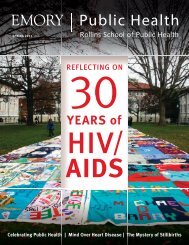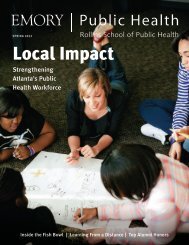returning quality to life - Woodruff Health Sciences Center - Emory ...
returning quality to life - Woodruff Health Sciences Center - Emory ...
returning quality to life - Woodruff Health Sciences Center - Emory ...
Create successful ePaper yourself
Turn your PDF publications into a flip-book with our unique Google optimized e-Paper software.
What is IANPHI?<br />
The International Association of National Public <strong>Health</strong> Institutes links<br />
and strengthens the world’s national public health institutes, boosting<br />
the capacity of low-resource countries <strong>to</strong> identify and prevent health<br />
risks and ultimately save lives.<br />
Members:<br />
Direc<strong>to</strong>rs from CDC-like organizations in 72 countries, from Afghanistan<br />
<strong>to</strong> Vietnam, representing more than 60% of the world’s population.<br />
Brain S<strong>to</strong>rm:<br />
Jeffrey Koplan, former direc<strong>to</strong>r of the CDC and now direc<strong>to</strong>r of <strong>Emory</strong>’s<br />
Global <strong>Health</strong> Institute, and Pekka Puska, his counterpart at Finland’s<br />
National Institute for <strong>Health</strong> and Welfare (THL), envisioned IANPHI in<br />
2001 after fielding ongoing questions from public health leaders in other<br />
countries about how <strong>to</strong> best track and respond <strong>to</strong> disease outbreaks.<br />
Founding Partners:<br />
Bill and Melinda Gates Foundation, Rockefeller Foundation, and WHO.<br />
IANPHI’s member institutes provide ongoing technical expertise and<br />
support for long-term development projects in 10 countries.<br />
Current Projects:<br />
Short-term seed grants range from malaria control in Guinea-Bissau <strong>to</strong><br />
analyzing extremely drug-resistant TB in Peru.<br />
Why is IANPHI Important?<br />
<strong>Health</strong> risks are global. Weak disease detection and response<br />
systems in one country weaken the world.<br />
For more info:<br />
www.ianphi.org<br />
For some who survived, they had lasting<br />
brain damage. Villagers had their own<br />
theories about the mysterious attacks, but it<br />
<strong>to</strong>ok a developing public health structure in<br />
Bangladesh <strong>to</strong> solve the mystery.<br />
With help from the CDC, scientists<br />
at the Institute of Epidemiology, Disease<br />
Control, and Research (IEDCR) in<br />
Bangladesh tracked the cause of the disease<br />
<strong>to</strong> Nipah, an emerging virus first seen<br />
in nearby Malaysia six years earlier. In<br />
Malaysia, pigs carried the virus, but in<br />
Bangladesh, it turned out <strong>to</strong> be bats.<br />
December opens the season for date<br />
palm juice, a delicacy collected like maple<br />
syrup, shared with friends and family, and<br />
drunk raw. The juice was a common fac<strong>to</strong>r,<br />
but epidemiologists puzzled over how it<br />
could have become contaminated.<br />
Working with the International<br />
Centre for Diarrhoeal Diseases Research<br />
in Bangladesh, the scientists found their<br />
answer by using infrared cameras <strong>to</strong><br />
capture what happened at the date palm<br />
trees. The videos revealed that bats were<br />
licking the juice in the open collection<br />
buckets. The bats were infected with the<br />
Nipah virus, which causes no harm <strong>to</strong> the<br />
In Banglaesh, IANPHI helped the country mount a<br />
better response <strong>to</strong> the Nipah virus, cholera, and<br />
puffer fish poisoning.<br />
Winter 2011<br />
9
















